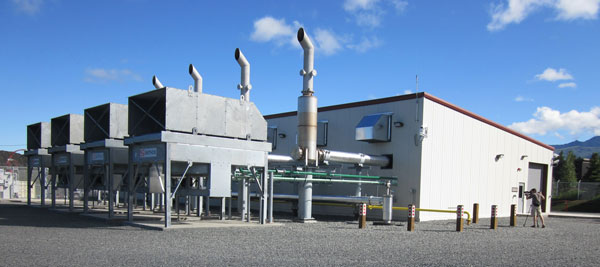
Officials fired up the state’s first methane power plant at the Anchorage Regional Landfill Tuesday. Doyon Utilities built the $26 million plant this summer. It uses methane gas created by decomposing garbage to create electricity. Doyon Utilities, The Municipality of Anchorage and Joint-Base Elmendorf Richardson partnered on the project.
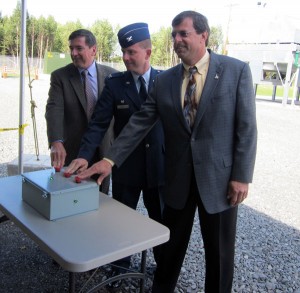
Dignitaries gathered to celebrate completion of the plant, which has been in the making since 2004. Dan Gavora is the president of Doyon Utilities. Hey says the plant is a win for all involved.
“The energy we create with this plant will generate revenue for the city, provide energy security for the joint base, lower overall energy cost and reduce pressure on local energy infrastructure and resources. All using, what until now, was an undesirable bi-product of city waste collection, an emission that had to be collected and flared to meet environmental protection standards,” Gavora said.
It’s also a win for Doyon Utilities. The company – owned by Doyon Limited and Fairbanks Sewer and water – was created in 2005 specifically to service the military installations in Alaska. The plant will offset the power usage for the Fort Richardson part of JBER in Anchorage. The landfill was creating methane gas anyway, but until now they were ‘flaring’ it, as required by EPA guidelines. Now, instead of being released into the atmosphere as pollution, it’s being funneled into a 6,000-foot pipeline leading to the plant.
“It comes in, we reduce it down to one and half pounds, it goes into the turbo charger, goes into the engine, it burns the gas, drives the generator and makes electricity,” Marvin Riddle, who is managing the project for Doyon Utilities, said.
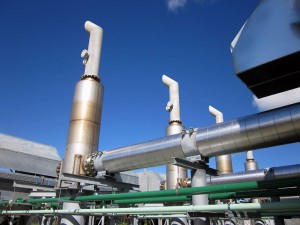
The plant is equipped to burn methane from the landfill and natural gas. When there’s not enough methane, it will switch over to using natural gas. Right now it produces 5.6 megawatts of power feeding directly into the grid. That offsets JBER-Richardson’s summer power usage by 80 percent and supplies 55 percent of their winter power needs. There’s room for expansion as the city, the base and the landfill grow. The plant is, in part, a result of a renewable energy goal set by the Department of Defense in the early 2000s. Colonel Bryan Duffy is the commander of Joint Base Elmendorf-Richardson and the commander of the 673rd Airbase Wing. He says the plant just made sense.
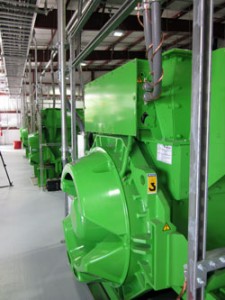
“When you’ve got a landfill that’s got to be tended to, a privatized partner in the utility system like Doyon and the electrical demand has, and honestly is competing for supplies that affect the local community, it just made a lot of sense to see this project move forward and we’re glad to see it today,” Duffy said.
The Anchorage Assembly awarded Doyon Utilities the project in 2011 and it was completed this summer with the aid of a $2 million construction grant by the Alaska Energy Authority.
Anchorage Mayor Dan Sullivan was on hand to celebrate the project. He says he’s excited about the many independent power projects being developed in Southcentral Alaska.
“We know that across the inlet Ormat’s looking for geothermal possibilities. We’ve got, of course, the Watana Dam, looks like it’s moving forward. Hydro certainly is renewable. Some of the coal seam projects may not be true renewables, but they’re certainly unconventional and the ability to use coal without mining it and burning it in the atmosphere is pretty exciting and of course the wind farm – maybe by this fall we’ll see turbines spinning for the wind farm. So a lot of exciting things are happening for renewable energy resources,” Sullivan said.
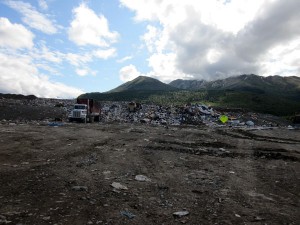
Officials says the municipality is expected to collect over $51 million in revenue from the sale of its landfill gas fuel supply and project-related property tax revenues over the 20-year term of the contract. The federal government will obtain electricity at a lower cost with an estimated savings of $32 million over that period. And JBER will exceed its federally mandated goals for renewable energy. Methane power plants are quite common in the Lower 48. But this is the first one in Alaska – and likely the only one for a while. According to officials, Anchorage is the only city in the state big enough to supply enough garbage, and methane, to produce power.
Daysha Eaton is a contributor with the Alaska Public Radio Network.
Daysha Eaton holds a B.A. from Evergreen State College, and a M.A. from the University of Southern California. Daysha got her start in radio at Seattle public radio stations, KPLU and KUOW. Before coming to KBBI, she was the News Director at KYUK in Bethel. She has also worked as the Southcentral Reporter for KSKA in Anchorage.
Daysha's work has appeared on NPR's "Morning Edition" and "All Things Considered", PRI's "The World" and "National Native News". She's happy to take assignments, and to get news tips, which are best sent via email.
Daysha became a journalist because she believes in the power of storytelling. Stories connect us and they help us make sense of our world. They shed light on injustice and they comfort us in troubled times. She got into public broadcasting because it seems to fulfill the intention of the 4th Estate and to most effectively apply the freedom of the press granted to us through the Constitution. She feels that public radio has a special way of moving people emotionally through sound, taking them to remote places, introducing them to people they would not otherwise meet and compelling them to think about issues they might ordinarily overlook.




